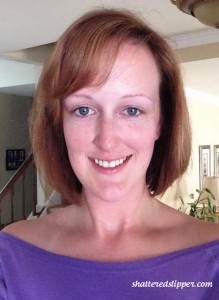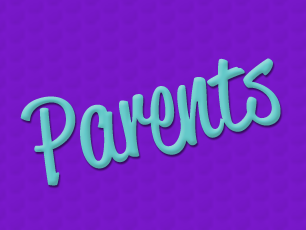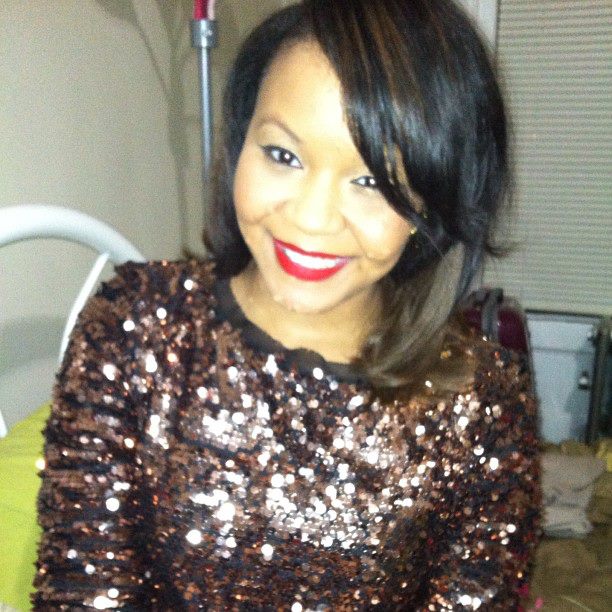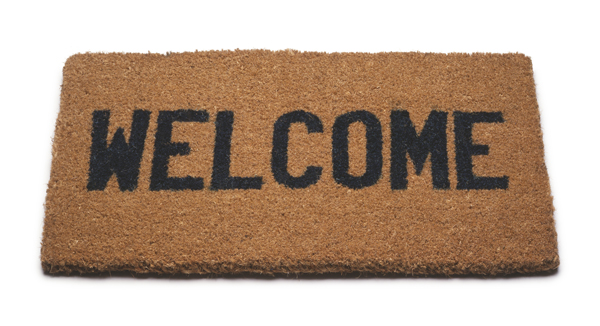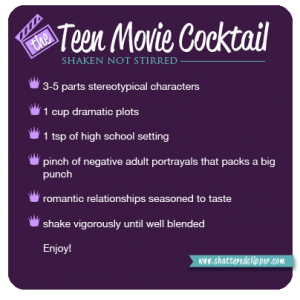
We’ve all watched them at sleepovers, rewatched them, and quoted them while out to lunch with friends. Teen movies were the epicenter of all things and they were relatable because the teenage years are typically a time of relationship and identity growth and struggle (#strugglebus), which is why there is a distinct recipe for many teen movies that started back in the 1950s, developed through the ‘80s and ended with what we are familiar with as “the teen movie” from the late 1990s and early 2000s.
After spending several Sundays cuddled up on my couch watching and rewatching teen movies, I forced myself to get physical, physical focused and put my analytical panties on instead of quoting every scene verbatim. I viewed two classic classic movies, Rebel Without a Cause (1955) and The Breakfast Club (1985). I also viewed four teen films from the 1990s and early 2000s, She’s All That, Never Been Kissed, Mean Girls, and 10 Things I Hate About You, all of which I now consider classics (of my time) as well.
From our Teen Movie Cocktail we concocted above one of the most used ingredients was character type. So let’s plug our noses and hold our breath as we take the plunge off the diving board into a deep pool of character types.
In the beginning of 10 Things I Hate About You and Mean Girls a minor character showed the main character around explaining the rules of high school and the different cliques and stereotypes. A few of the labels mentioned in those two movies were “burnouts,” “sexually active band geeks,” “girls who eat their feelings,” “cool Asians,” and “white Rastafarians,” just to name a few. The most frequently represented cliques were the popular crew and the losers. While not all the movies I’ve seen included such a blatant introductory scene, almost all were populated by stock character types.
Pop.u.lar.—
The Queen Bee
[ leader of her pack, trend-setter, mostly aloof ]
One such character was the popular girl or “queen bee” who is wealthy, naïve, and snobby (cue hair flip). Often she was seen leaving campus in her convertible car enroute to the mall with pals. One character that screamed “queen bee,” is Regina George from the movie Mean Girls. She was the one with the silver Lexus convertible, long blonde hair, designer clothes, a room the size of a house, and rules for the lunch table— “on Wednesday’s we wear pink.” Her girl crew was appropriately given the name “The Plastics,” teen royalty. The audience knew Regina was the “queen bee” when Cady (the new girl in school) was trying to sabotage Regina’s reputation and cut two holes in her tank top showing off Regina’s bra. It wasn’t long until every girl in school was sporting this idiotic fashion “trend.” Regina is “the Barbie Doll I never had.”

The Breakfast Club. Claire the Queen Bee in pink. image from ign.com movie review.
The popular girl image hasn’t changed much from the Rebel Without a Cause and The Breakfast Club eras but its attitude has (oh snap!) from the coy, sweet and kind to the dominant “mean girl.” For example, Judy from Rebel Without a Cause came from a wealthy family, (which is safe to assume from the interior of the family home), however she was as sweet as could be. She also was a tad naïve when it came to falling in love. Claire of The Breakfast Club was the “princess.” She wore diamond earrings and brought sushi for lunch, claiming her elite status, however, through her dialogue she didn’t seem as stuck up or outspoken as Regina George in Mean Girls. One thing that separated Judy and Claire from the mean girls of the current films was the fact that they confessed their weaknesses and their dislike with their popular status. These factors humanized these characters, however, an emotional confession was never heard from the popular girls in the current films.
The Jock
[ swoon-worthy, athletic, little to no brain waves ]
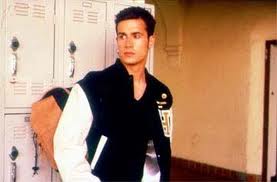
Character from She’s All That sports a letterman jacket to identify his “jock” status. image from kron.buzznet.com
There was the popular boy or “jock” that was always charming, sometimes conceded, good looking and ruled the school. He was the guy who got high fives for no reason while walking through the locker-lined halls. Often times the popular boy was struggling with the future and growing out of his popularity. A prime example of this is the character, Zach, played by Freddie Prinze Jr. in She’s All That (bats eyelashes). He was always sporting his letter jacket, representing his status, and a smile that melted every girl’s heart. Though he was portrayed in this stereotypical light, he was also very intelligent as the class president and a senior that got accepted into Ivy League schools like Yale and Harvard. This was a rarity in teen films. In Mean Girls, Aaron Samuels, the hot senior boy that all “The Plastics,” wanted attention from, was a soccer player that lacked the talent it took to succeed in calculus. Too often males are portrayed with less intelligence because the more important qualities are that they are athletic all-stars and practicing courtship on the popular girls to enhance their social standing. Andy from The Breakfast Club was the typical jock, pressured to excel on the wrestling mat from his dad and coaches. He was always wearing his letter jacket and packed a hefty lunch of four sandwiches. Joey the conceded male model in 10 Things I Hate About You focused on his good looks, often catching reflections of himself in glass throughout the school day so he could fix his hair.
The Mean Girl
[ socially aggressive, revenge seeking, fake front ]
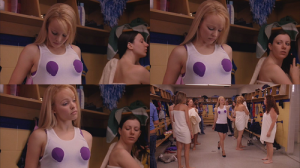
Cady cuts holes in Regina’s shirt after gym class and it becomes a fashion trend around school. Peer pressure dictated by high school popularity standards. image from templekids2011.wikispaces.com
If a mean girl is defined as a character who is a direct user of socially aggressive behaviors that consists of “indirect aggression to damage another’s status or self-esteem spreading rumors, silent treatment, note passing, backstabbing, public of private humiliation.” Who really is the mean girl in Mean Girls? Is it Regina, who on the surface seemed to fit the mean mold? Nope. It was Cady who used socially aggressive tactics (listed above) to sabotage Regina’s life and “queen bee” reputation. Another set of “mean girls,” they always seem to come in a set, are the trio of girls from Never Been Kissed. Similar to “The Plastics,” they were always flaunting their bodies in revealing crop tops and short skirts. They picked on the nerdy math girl, Aldys or “Alpo,” as they called her. The last scene almost caused the biggest form of public humiliation for Aldys. The popular guy, Guy, (original, ha!) asked her to dance. While twirling around on the dance floor, one of the girls took out a can of Alpo dog food from her pink purse and got one of the popular guys to help pry it open. Just when they were about to dump it on Aldys, Josie (undercover journalist turned popular) yelled and hit the can and the dog food ended up landing on the trio of mean girls. Hey Karma, how you doin’?
Next week: how Outsiders or “losers” character type become Insiders, or a member of the Popular crew, with a quick wardrobe change. I smell a makeover sequence!

